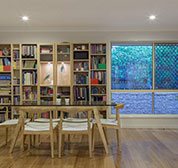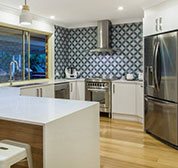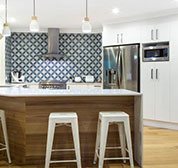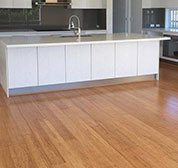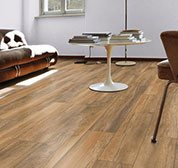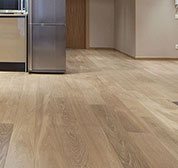Cork Flooring Guide
Natural cork floors are coming back. They’ve become the hottest new flooring on the market. In many ways natural cork is the perfect floor...its beautiful, warm, soft, tough, resilient, water resistant, anti-static, sound absorbing, and insulating. It is also naturally hypo-allergenic, anti-microbial and anti-fungal. Yet it is easy to clean - just sweep and damp mop! Whether in a kitchen or bathroom, a child's room, a family room or a music room, you’ll always be happy with your cork flooring. Natural cork comes from live cork oak trees which grow all around the Mediterranean coastal regions. Portugal and Spain produce the most cork, but France, Italy, Algeria, Morocco, and Tunisia are also producers.
Cork is truly a “green” flooring material
Natural Cork is a 100% naturally renewable resource carved from bark of the relatively slow growing cork oak tree. The species can survive unbelievably harsh conditions where not much else grows yet many trees continue to live for up to 500 years.
The trees are never injured in the harvesting process. The bark is regenerative, so it grows back after harvesting and no damage is ever done to the tree. It takes 9 to 11 years for the bark to grow back.
Throughout history, natural cork has been harvested the same way - by hand. The loosened bark is pried off in large sheets and then stacked and left for days to dry in the sun. There are many industrial uses of cork, but mainly it is used in the wine industry as bottle-stoppers. Cork flooring is made from the scrap or post-industrial waste of the wine-stopper industry. The cork scrap is ground up and then formed into sheets which are then made into flooring.
As with many other flooring products, recent developments in finishing systems have improved the overall performance and ease of maintenance. Cork flooring today offers a number of benefits unmatched by any other type of flooring material.
Comparison of natural cork with other floors
Natural Cork floors combine the best characteristics of hard surface and soft surface flooring. Nothing else compares: (Chart - courtesy of US Floors)
| Natural Cork | Carpet | Hardwood | Ceramic Tile | Vinyl/VCT | Laminate | |
| Natural Material | Yes | No | Yes | No | No | No |
| Comfort Underfoot | Yes | Yes | No | No | No | No |
| Wheelchair Use | Yes | No | Yes | Yes | Yes | Yes |
| Durable | Yes | Yes | Yes | Yes | Yes | Yes |
| Easy to Clean | Yes | Yes | Yes | Yes | Yes | Yes |
| Scratch Resistant | Yes | Yes | No | Yes | No | Yes |
| Acoustic Insulator | Yes | Yes | Yes * | Yes * | Yes * | Yes * |
| Thermal Insulator | Yes | Yes | Yes * | Yes * | Yes * | Yes * |
| Increases Home Value | Yes | Yes | Yes | Yes | Yes | Yes |
| Inherently Warm | Yes | Yes | No | No | No | No |
| * requires underlayment | ||||||
Cork Floors are available in several formats:
Natural Cork Tile - Tile or parquet, is generally available in 12" x 12" or 12" x 24" standard sizes and may be installed in the same manner as traditional vinyl or resilient flooring. In general, the sub-floor whether it’s a suspended wood floor or a concrete slab should meet the same standards as for sheet vinyl installations. The adhesive used should be that which is specified in the manufacturer’s instructions.
Natural Cork Plank – Generally the cork has been laminated to a central HDF core. This enables the installer to snap the cork flooring panels together without using tools or glue thus creating a “floating” floor installation. This method has several advantages:
- You can lay this system directly over your old floor!
- Less sub-floor preparation and may be installed below grade.
- Quicker installation – less costly and requires less skill.
- Use no separate underlayment because of corks low-density sound absorbing qualities.
- Ideal for raised access panel flooring systems.
- Ideal for radiant floor applications.
- Ideal for soundproof flooring in condos and apartment.
As with wood flooring natural cork plank requires a space around the perimeter of the room to allow for expansion and contraction. The expansion space is then covered by trim or baseboard.
Of all the recent technological innovations in flooring, nothing compares to the latest click-together milling techniques which enable the installer to interlock the planks. This technique ensures a very tight connection between planks and is glue less. So, there’s no mess, easier installation and consumes much less installation time.
Considerations
Finish– Today, as with other natural floors, the most common finish is factory applied polyurethane. The latest development in finishes is "anti-scratch", a more durable coating. If you prefer a paste wax finish, natural cork can also be purchased unfinished and then finished on site.
Care and Maintenance– Natural Cork, like other natural products develops a patina over time and looks better with age. Lasting beauty can be achieved simply by purchasing good material and taking care of it.
- Sweep or vacuum the floor regularly.
- Follow the manufacturer’s recommendations for cleaning materials. These cleaners should be sprayed or misted over the surface and damp-mopped up as you go.
- It is not a good idea to use the old "bucket and mop" cleaning method on a Natural Cork floor. Spills should be wiped up immediately.
- Place a non-rubber backed rug in kitchen work areas such as in front of the stove and sink.
- Minimize denting from furniture legs by using floor protectors under feet and furniture with casters.
- Protective mats are a good idea under office chairs.
Sensitivity to Sunlight- Because natural cork contains organic pigments, like wood, or fabrics made from natural fibers, it will fade over time. Avoid direct exposure to sunlight. The best solution is to use a UV protective film on your windows.
Sensitivity to Temperature and Humidity- All wood floor systems expand and contract in response to fluctuations in temperature and humidity. By controlling the environment, maintaining a moderate temperature and relative humidity around 50%, one can minimize the visible effects of the normal contraction and expansion of your floor.








